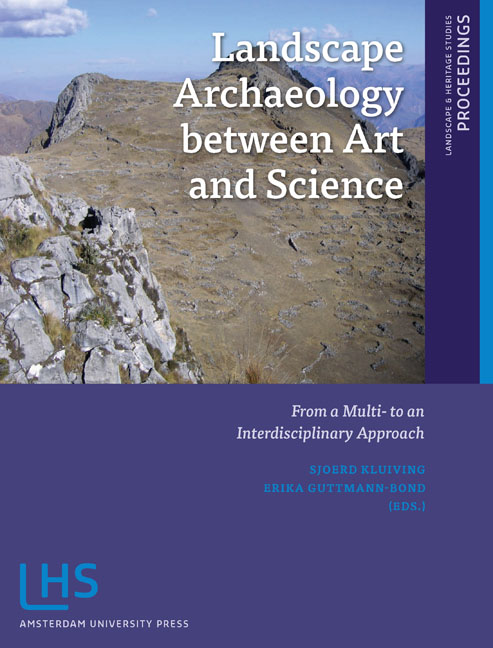Book contents
- Frontmatter
- Contents
- Preface
- Introduction: LAC2010: First International Landscape Archaeology Conference
- THEME 1 HOW DID LANDSCAPE CHANGE?
- THEME II IMPROVING TEMPORAL, CHRONOLOGICAL AND TRANSFORMATIONAL FRAMEWORKS
- THEME III LINKING LANDSCAPES OF LOWLANDS TO MOUNTAINOUS AREAS
- THEME IV APPLYING CONCEPTS OF SCALE
- THEME V NEW DIRECTIONS IN DIGITAL PROSPECTION AND MODELLING TECHNIQUES
- THEME VI HOW WILL LANDSCAPE ARCHAEOLOGY DEVELOP IN THE FUTURE?
- Miscellaneous Endmatter
5.10 - New Methods to Analyse LiDAR-based Elevation Models for Historical Landscape Studies with five time Slices
Published online by Cambridge University Press: 21 January 2021
- Frontmatter
- Contents
- Preface
- Introduction: LAC2010: First International Landscape Archaeology Conference
- THEME 1 HOW DID LANDSCAPE CHANGE?
- THEME II IMPROVING TEMPORAL, CHRONOLOGICAL AND TRANSFORMATIONAL FRAMEWORKS
- THEME III LINKING LANDSCAPES OF LOWLANDS TO MOUNTAINOUS AREAS
- THEME IV APPLYING CONCEPTS OF SCALE
- THEME V NEW DIRECTIONS IN DIGITAL PROSPECTION AND MODELLING TECHNIQUES
- THEME VI HOW WILL LANDSCAPE ARCHAEOLOGY DEVELOP IN THE FUTURE?
- Miscellaneous Endmatter
Summary
ABSTRACT
Light Detection and Ranging (lidar ) data and derived Digital Elevation Models (DEM) have been available in the Netherlands since 2001. These models have recently become an accepted method within archaeological and historical research. Nevertheless, the use of lidar images for landscape characterisation by governmental organisations and institutions that deal with area management is still in its infancy.
The provincial authority of Gelderland commissioned ADC ArcheoProjecten to compile an atlas of lidar -based elevation models within its boundaries. Its purpose was to increase the application of the atlas within governmental organisations. To simplify the interpretation of the lidar -based elevation models in the atlas, a new method of time-depth was introduced by defining time slices. For each time slice, images from characteristic features were made with different visualisation techniques, depending on the character of the chosen subject. The lidar -based elevation images were printed next to historical and topographical maps or photographs to clarify the interpretation. To explain each image, information about the geomorphological, historical or archaeological features was added. The method was tested in four regions, each with different geomorphological and historical characteristics. The results were discussed with the potential users of the lidar -based atlas from different governmental organisations in the region. This new method, using the five time slices, proved to be a useful tool for analysing lidar -based elevation images. These images provide valuable input to (historic) landscape characterisation, which has the potential to be a substantial resource for heritage-related, archaeological and historical research as well as landscape and urban design.
KEYWORDS
archaeology, geomorphology, historical geomorphology, digital elevation models, LiDAR, landscape characterisation, time depth
INTRODUCTION
lidar data and derived digital elevation models (DEM) have been available in the Netherlands since 2001. The detailed measurements of the ground surface at metre and sub-metre resolution generate spectacular images of the relief, revealing the natural landscape, archaeological and historical geographical features as well as features relating to modern human activities (Laan & Van Zijverden 2004; Waldus & Van der Velde 2006; Van Zijverden & Zuidhoff 2009). lidar measures with a resolution and accuracy hitherto unavailable, except through labour-intensive field survey or photogrammetry (Bewley et al. 2005). The lidar -based images contribute to studies based on geological and historic mapping and archaeological data, and are for example used for landscape biography studies (Van Beek 2009; Bewley et al. 2005; Lewis et al. 2008; Shell & Roughley 2004).
- Type
- Chapter
- Information
- Landscape Archaeology between Art and ScienceFrom a Multi- to an Interdisciplinary Approach, pp. 443 - 458Publisher: Amsterdam University PressPrint publication year: 2012



